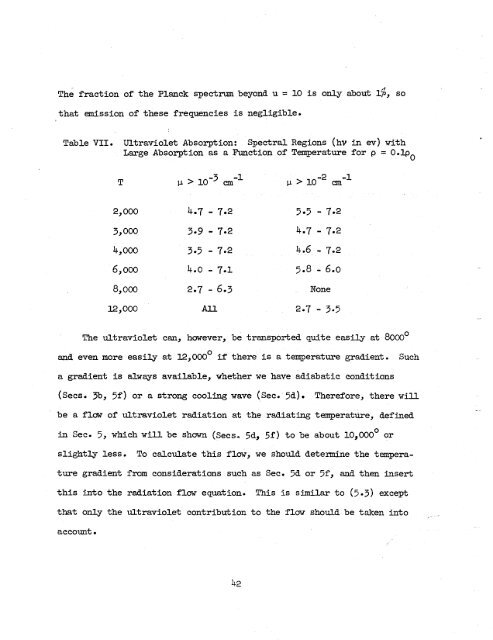Theory of the Fireball
Theory of the Fireball
Theory of the Fireball
Create successful ePaper yourself
Turn your PDF publications into a flip-book with our unique Google optimized e-Paper software.
The fraction <strong>of</strong> <strong>the</strong> Planck spectm beyond u = 10 is only about Y$, so<br />
that dssion <strong>of</strong> <strong>the</strong>se frequencies is negligible.<br />
Table VII. Ultraviolet Absorption: Spectral Regions { hv in ev) with<br />
Large Absorption as a Function <strong>of</strong> Temperature for p = O.lpo<br />
T I.L > 10-3 LL > m’l<br />
2,000 4.7 - 7.2 5.5 - 7.2<br />
3,000 3.9 . 7.2 4.7 - 7.2<br />
4,000 3.5 - 7.2 4.6 - 7.2<br />
6,000 4.0 - 7.1 5.8 - 6.0<br />
8,000 2.7 - 6.3 None<br />
12,000 All 2.7 - 3.5<br />
The ultraviolet can, hawever, be transported quite easily at 8000~<br />
and even more easily at 12,000° if <strong>the</strong>re is a temperature gradient . Such<br />
a gradient is always available, whe<strong>the</strong>r we have adiabatic conditions<br />
(Secs. 3, 5f) or a strong cooling wave (Sec. 5d) Therefore, <strong>the</strong>re will<br />
be a flow <strong>of</strong> ultraviolet radiation at <strong>the</strong> radiating temperature, defined<br />
in Sec. 5, which will be shown (Secs. 5d, 5f) to be about 10,OOOo or<br />
slightly less. To calculate this flow, we should determine <strong>the</strong> tempera-<br />
ture gradient from considerations such as Sec. 5d or 5f, and <strong>the</strong>n insert<br />
this into <strong>the</strong> radiation fluw equation. This is similar t o (5.3) except<br />
that only <strong>the</strong> ultraviolet contribution to <strong>the</strong> flow should be taken into<br />
account.<br />
42
















